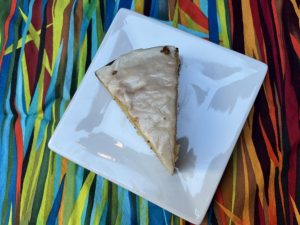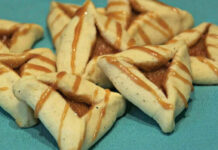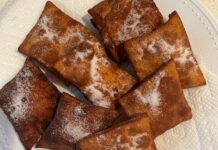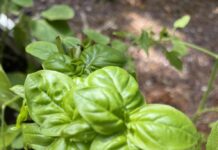These two recipes are very different but equally delicious.
The first, a vanilla riff on a classic Italian lemon ricotta cake, leans heavily into dairy and requires a bit of effort but is truly delicious.
The second, a pareve/vegan chocolate cake designed to feed one or two, is a classic pantry recipe that is surprisingly tasty. Most reasonably stocked kitchens will be equipped with the ingredients needed for the chocolate cake, and it is simple to make.

Vanilla Ricotta Cake | Dairy
Makes one 9-inch cake
I had a surplus of ricotta cheese in my fridge recently; I’m a sucker for “buy 2, get one free” promotions. I used two containers for lasagna and mulled the third.
One rainy Saturday, I had the urge to bake, and this cake suggested itself. The original recipe calls for lemon instead of vanilla, and I had no lemons but, given the weather, I was loathe to venture out. I had plenty of vanilla, both extract and paste, so I went with that. If you don’t have vanilla paste, just use an extra teaspoon of extract.
The results were great; over the next several days, two guests who claim to “not like cake” came back for seconds. If you prefer the lemon version, simply omit the vanilla from both the batter and the glaze. For the cake, use the zest and juice of 1 whole lemon or 1 tablespoon of lemon extract. For the glaze, use the juice and zest of ½ lemon or 1 teaspoon of lemon extract.
- Butter and powdered sugar for the pan
- 1½ sticks butter, softened
- 1½ cups sugar
- 1 15-ounce container ricotta cheese
- 3 eggs
- 2 teaspoons vanilla
- 1 teaspoon vanilla paste
- ½ teaspoon baking soda
- ½ teaspoon salt
- 1½ cups flour
For the glaze:
- 1 cup powdered sugar
- 1 teaspoon vanilla
- 1 teaspoon vanilla paste
- 2-3 tablespoons milk (adjust for proper consistency)
Heat your oven to 350 degrees F. Grease a 9-inch springform pan with butter, then dust it with about ¼ cup of powdered sugar. Set it aside.
Cream the butter and sugar in a mixer, then add the ricotta and beat until fluffy, about 4 minutes. Add the eggs, one at a time, and blend, then add the vanilla extract and paste, if using. Add the baking soda and salt, then add the flour and mix briefly until just combined (do not overmix or the cake will be heavy).
Pour the batter into the prepared pan and bake it for 45 minutes until the center springs back and the cake is a light golden brown. Cool the cake for 10 minutes in the pan, then remove the rim.
While the cake is cooling, make the glaze: Mix all the ingredients with a fork or whisk it until smooth. When the cake is completely cool, drizzle the glaze over the top.
Wacky Cake | Pareve
This cake lived up to its name. I teach a monthly cooking class at an organization that supports individuals with disabilities to live independently. We have a great time, and the students leave with the fruits of their labor to enjoy in their apartments.
Recently, one of the students requested a chocolate cake for the next lesson. Because of the logistics, we always create individual portions for the participants to take home, so I sought a single-serving recipe.
I found this “wacky cake,” a rich chocolate cake that is reputed to date to the World War II era when cooks had to work around rationing. I scaled it to a small quantity, and it was shockingly delicious.
When I introduced the recipe, I explained the cake’s history and the need for cooks at the time to be creative due to shortages of staple ingredients such as butter and eggs. We made the cakes, put them in the oven, and one of the participants remarked about the sugarless cake and asked about other cakes that had similar substitutions.
I was like, “What do you mean ‘sugarless’?” and then I checked the recipe … somehow I had omitted the sugar from the written recipe. Even though I had brought a bag of sugar to the demo kitchen, it never made it into the batter. Rut-roh.
I semi-panicked; there wasn’t much to do now that the cakes were baking. But cooking requires the ability to pivot, and that’s what we did. I ransacked the demo kitchen for remedies, and we found Nutella, chocolate syrup, milk, Marshmallow Fluff, a can of frosting and sprinkles.
We mixed the chocolate syrup with the milk and, when the cakes came out, soaked the cake with it, tres leches style. Then we offered the students the other ingredients to top and decorate the cakes. It wasn’t the goal, but it worked out pretty well. And now I have a plan for next month’s class: chocolate cake with sugar.
Mini Chocolate Cake
Serves 1 or 2
One beautiful thing about this cake is the lack of mess — you mix the batter right in the pan!
- ½ cup flour
- ¼ cup sugar
- 2 tablespoons unsweetened cocoa powder
- Pinch salt
- ½ teaspoon baking powder
- ½ teaspoon vanilla
- 2 tablespoons oil
- ¾ teaspoon white vinegar
- ⅓ cup hot water
Grease a mini loaf pan. Heat your oven to 350 degrees F.
In the pan, mix the dry ingredients with a fork or a small whisk. Make 3 little wells in the mixture. In one well, place the vanilla, another the oil and the last the vinegar. Pour the hot water over the whole mixture. Whisk until blended. Bake it for about 18 minutes until the middle of the cake is done and no longer wet.
Let the cake cool slightly, and top as desired with frosting, chocolate syrup, caramel, butterscotch, jam, whipped cream, ice cream, etc.
Keri White is a freelance food writer.







